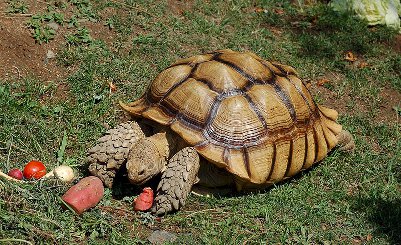Raising African Spurred Tortoise
Category: Turtle

Facts about Raising an African Spurred tortoise. "Scientific name for African Spurred tortoise is Centrochelys sulcata". also called the Grooved Tortoise or Sulcata tortoise. You should first find for you Grooved Tortoise a qualified reptile vet, one that has examined the African Spurred tortoise before. You should have the vet preform a thorough examination and a complete fecal culture (direct smear as well as flotation) to check for all worms and parasites, Giardia, Hexamita Parva, etc. Most of the time the African Spurred tortoise that comes from the wild, will have these parasites.
The best ground heat, is ground heating under the tank or heat pad. African Spurred tortoises do the best basking heat from above, it replicates the natural heat from the sun. You want to make sure you properly size the basking heat source and the wattage is not to high. You must also take into consideration that if the temperature in the room gets above 80 degrees F (27 cel), make sure you shut down the heat source to not over heat your African Spurred tortoise.
You want the tank to be a minimum of 2 feet (.60 meters) long and 1 foot (.39 meters) wide for a hatch-ling, no smaller than that. The African Spurred tortoise is not be housed in a ( vivarium-type) tank such as a fish tank or glass aquarium. The African Spurred tortoise should be housed in a open enclosure-type environment. You can go to David T. Kirkpatrick, Ph.D, How to Build an Indoor Land Turtle Table.
If out door sun light is not provided, a fluorescent full spectrum UVB bulb is recommended, so you African Spurred tortoise can develop in the proper environment along with the proper heat. UVB is necessary for the animal to produce Vitamin D3, which aids in calcium utilization for a healthy shells growth. The box of the bulb must specify a UVB bulb. Don't get confused between a heat-basking bulb and a fluorescent bulb. Make sure you have two to four thermometers, one for the floor and one or two for the walls, so you don't get a false reading with just one. It is very important to maintain the proper temperature at all times.
One thermostat should be close to the heat lamp, to monitor the temperature, you don't want it to get to hot especially for the hatch-lings. Make sure the pen never goes below 73 degrees F (23 cel) . Under heating is as bad as over heating. A good temperature setting in the enclosure is 85 F (29 cel) in the hot zone of the enclosure and 73 to 75 (23 to 24 cel)in the cool zone for the tortoise.
You need to soak your hatch-ling tortoise 3 times a week, this is important. After one year your tortoise is considered a juvenile you can still soak him 2-3 times a week. A adult sulfate tortoise should be soaked once a week for the rest of his life. You should soak 5 to 10 minutes at a time. Make sure you dry your African Spurred tortoise off after its bath before he goes back in his home. Large African Spurred tortoise should have a shallow outdoor pool for soaking and wading. The water should be Lukewarm and no deeper than the bottom shell. A small dish basin is ideal for, easy clean up, just empty the old water when clening in the toilet. Remember this is all for indoor raised African Spurred tortoises. Outside they can set up their micro climate so such frequent soaks are not as necessary.
Do not over feed your sulcata tortoise, one feeding per day is plenty. 1/4 cup for the first six months for the hatch-ling stage, then 1/4 to 1/2 cup of greens for a African Spurred tortoise hatch-ling 6 months to a year of age. After one year, a juvenile African Spurred tortoise should get no more than 1 cup of loosely packed greens per day. If juveniles are feed to much they can grow far to quick, this can cause shell, bone and mineral deficiency problems. Slow steady growth is a must.

 Back To Category Turtle
Back To Category Turtle